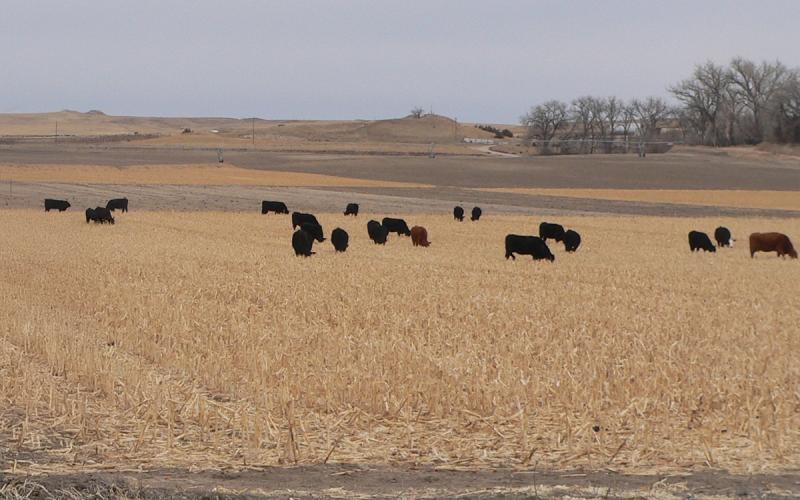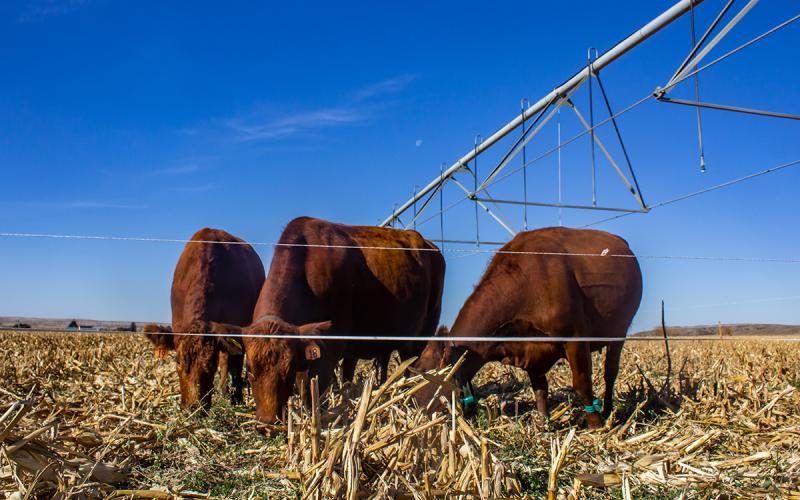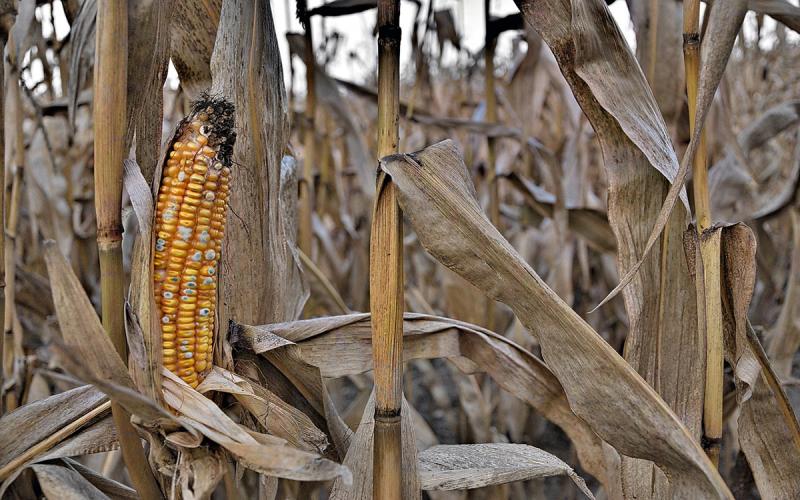With a very challenging harvest in many parts of south and southeastern South Dakota this year, farmers were faced with difficult decisions. Wet, unfrozen ground in many areas and high grain moisture forced many farmers had to make a decision: harvest the wet grain, or let it stand in the field.
Winter Standing Corn Considerations

At this time of year, there typically is not any significant field drying that will occur in corn (Table 1). Most farmers are well aware of the risks that come with leaving corn standing over the winter, hoping corn stalks and cob shanks withstand winter winds and snows, so that a dryer harvest can occur in the spring. Losses from leaving corn standing over the winter vary greatly depending upon many factors like variety selection, field management, and weather. When making late harvest decisions, it is important to take the economic comparison of storing and drying high moisture corn versus field losses and damage to wet soils into consideration.
| EMC (%) | PET (in) | Est. Drying (%pt) | ||
|---|---|---|---|---|
| Month | Week | |||
| Sep | 15 | 4.0-5.0 | 18 | 4.5 |
| Oct | 16 | 2.8-3.5 | 11-12 | 2.5 |
| Nov | 19 | 0.8-1.2 | 4-5 | 1 |
| Dec | 20 | 0.5-0.8 | 2 | 0.5 |
| Jan | 21 | 0.5-0.8 | 2 | 0.5 |
| Feb | 21 | 0.5-0.9 | 3 | 0.8 |
| Mar | 19 | 1.3-1.6 | 5 | 1 |
| Apr | 16 | 3.2-4.5 | 16 | 4 |
| May | 14 | 6.5-8.5 | 30 | 7 |
|
PET: Potential Evapotranspiration (based on factors similar to those that affect drying) |
||||
If snow melts and soils allow, some farmers may opt to harvest yet this winter. In such a case, before harvesting, consider estimating the cost of propane if high heat drying is in the plans. According to Dr. Kenneth Hellevang: “To estimate the propane cost of drying per bushel per point of moisture removed, multiply the propane price per gallon by 0.02. For example, the cost to remove 10 points of moisture using $1.50 propane is $0.30 per bushel. Dividing the propane cost by the corn price provides the percentage of corn losses that will equal the drying cost ($0.30 divided by $3.50 equals 9%). Also, verify the impact on insurance of leaving the corn in the field.”
There are a few exceptions to this rule however:
- Newer dryers with saturators and vacuum cooling might improve efficiencies.
- ‘Wet points’ do tend to come off easier than the dry points. For example, 14% moisture is harder to reach from 19% and will take more energy on average than drying corn from 25 to 20%.
Watching Wet Corn in Storage

Although there are still fields in the southern part of the state with corn still standing, one can assume there is also a fair amount of relatively wet corn in storage. With high moisture corn, bin temperature is extremely important and should be monitored in various parts of the bin on a weekly basis at minimum. Probe around the bin using a grain thermometer in several places, allowing the thermometer several minutes to equalize before moving to the next site. If you detect heating in the grain or there is more than a 5-8 degree difference in temperature between any two areas in the bin, run the aeration fan immediately (Dorn, UNL).
The goal of binning high moisture corn is to freeze the corn over the winter, keeping the temperature between 20-30°F.
- Holding very high moisture corn (22-24%) is possible in the bin but extreme care should be taken to avoid spoilage. Monitoring temperature and keeping it near 20°F throughout the bin is key. Grain at this high moisture level will likely need to be ran through a high temperature dryer by early March when temperatures begin to rise. On average, the south bin wall receives more than twice as much daily total solar energy heating in February than it does in June, making temperature monitoring imperative (Hellevang, NDSU).
- Corn from 19-21% moisture allows the operator to choose between high heat drying or natural air drying if the proper equipment is available. As spring approaches, grain should be monitored, and a drying decision should be made.
- When using natural air drying, it is extremely important that access to the proper fan size is available, or suitable drying will not occur. For assistance determining required airflow rate and fan size necessary for your bin see the U of M Fan Selection Program.
Other Tips
When using fans to cool grain or maintain temperatures in the winter, care should be taken to avoid bringing moisture back into the bin. Turning fans off and keeping them covered during periods of precipitation or fog can help ensure quality of grain. In addition, leaving extra air space in bins and leveling off grain can also help ensure that grain is frozen evenly throughout the bin. To test corn moisture, be sure to allow grain to warm up to at least 40°F for an accurate moisture meter reading.
Although it’s been a tough harvest year in many parts of southern South Dakota, farmers still have grain storage options that can help maintain quality over the winter as long as bins are checked regularly and precautions are taken to avoid spoilage as spring temperatures draw closer.
Resources and References:
- Dorn, T. UNL CropWatch. Managing High Moisture Stored Grain Through Winter.
- K. Hellevang, NDSU Grain Drying and Storage. High Moisture Corn Drying and Storage Presentation.
- Hellevang, K. NDSU News. Corn Harvest Drying Storage Challenging this Year.
- Wilcke, W and Wyatt, G. UNL Fact Sheet. Grain Storage Tips.


